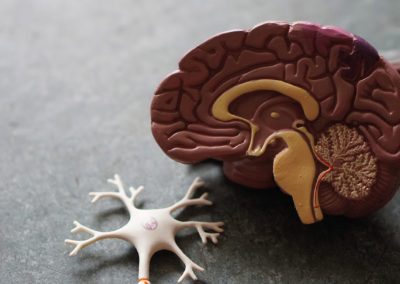performance or increase their mental well-being for a long time. Or at least as much as possible by taking psychoactive substances or by connecting one’s brain to a computer. Improved sensory performance or motor skills should also be achieved in this way. Given the impressive progress made in brain research, computer science and pharmacology, such stimulation seems quite achievable. Both serious researchers and authors in the science fiction world never tire of writing about the breakthrough of such possibilities in the next few years.
In addition, there are many attempts to improve one’s own performance or well-being with the capabilities that already exist today. Two groups of drugs with different effects are in use. The first group includes drugs from the methylphendiates class (Ritalin, Concerta) and amphetamines (benzidrine) or modafinil, which have long been known to be invigorating drugs. These drugs are supposed to work as a ‘turbo’ to better prepare for exams, endure stressful situations at work or impress in a company with brilliant thinking. There are many reports of students, academics or managers resorting to such drugs on a regular basis. At a closer look, however, these figures are not so impressive, since, for example, even a single use of such drugs is taken as evidence of their widespread use. Cognitive effects in the sense of improving memory or speeding up thinking are either not proven for the drugs in question at all, or are proven only for small specific groups of people.
The second group of drugs is more interesting. These include donepezil or ampequin. The latter are small molecules which improve signal transmission in the brain. Studies have shown that ampecins improve memory and learning ability in older people. Of the many psychoactive substances, piracetam remains interesting for further development, with long-term studies showing a 30 per cent improvement in psycho-cognitive ability. True neuroenhancers are supposed to improve mental capacity in the long term, or at least prevent its decline over the course of a lifetime or in the case of certain diseases. That is why today they are mainly used for the treatment of specific diseases rather than as generally available drugs to improve cognitive ability.
It can be assumed that in the future, new drugs developed against dementia and for patients with Alzheimer’s disease will also be available to healthy people. Progress is accelerated by the exponential development of computing technology. Molecular computers and quantum computers make it possible to simulate brain functions and thus develop drugs that are targeted from the start.
In addition to specially developed drugs, there is also a large group of herbal remedies that also help improve brain function. One example is the small Thistle leaf (Bacopa monnieri), which grows in Asia, Africa, China and South America. But its effects are, to say the least, controversial or unproven.
Freely available remedies for optimising brain function are also a bridge to optimising brain function on an everyday level, so to speak. Energy drinks and dietary supplements have already become mainstream. While the former help boost instant performance and thus provide the aforementioned turbo function, the latter are linked to the hope of supplying the body with important substances that are in insufficient amounts found in ordinary food. In particular, superfoods are currently enjoying a great success among young people, which is attracting many investors. These include goji berries, chia seeds, moringa, acai berries and blueberries. For all of them it is true, however, that the health benefits proven in animal experiments at high concentrations can hardly be transferred to everyday life.
What about the impressive direct connection between the brain and the computer? With increasingly powerful computer technology, the desire to communicate with the computer not by keyboard or speech, but from brain to brain, so to speak, is obvious. The first methods for this have already been successfully developed and are now available for use in games. The technical basis is the electroencephalogram (EEG), which has long been used in medicine to monitor brain function. Here, brain activity is measured by sensors on the scalp. The devices used in research laboratories resemble bathing caps with countless wires sticking out of them, through which the measured brain waves are transmitted. Companies such as Neurosky or Emotiv already offer futuristic-looking high-tech headbands for everyday use. With these so-called neuro-wearables, anyone can measure and monitor their own brain activity or control devices. Devices that allow paraplegics to control a wheelchair or other devices solely by means of brainwaves have been known for some time. However, this requires an intensive learning process. During this process, patients learn how to activate certain areas of the brain to control the wheelchair and thus generate impulses that the computer translates into control signals. The EEG has so far not been used to read minds, but to measure the conscious activation of areas of the brain.
In the same way, Facebook is using EEG to develop speech recognition devices that can be worn on the scalp. They should make it possible to transfer thoughts directly into texts (e.g. e-mails). But the task is even more difficult than reading thoughts to control prostheses or external devices. Facebook scientists are focusing on the speech centre, and thus on the thoughts we actually want to express in words. However, reading thoughts from the speech centre is not the same as general mind reading, which is a nightmare for many people. Such speech recognition will not penetrate the innermost thoughts, but will only capture what should and can in any case be voiced.
Invasive procedures, in which electrodes are inserted into the brain, go much further. This in itself is not new and has been practised for many years in the form of deep brain stimulation, a kind of brain pacemaker, for therapeutic purposes for severe neurological diseases. However, researchers such as Neuralink, a company founded by Elon Musk, want to go much further and implant electrode mats or ticks into the brain and output the resulting signals from the head via cable. The selectivity of these methods is much higher than that of non-invasive methods. However, their main disadvantage is the huge health risk when the cables exit the brain through the skin. Moreover, they simply represent new forms of brain-computer interfaces. However, they do not enhance cognitive abilities in the narrow sense of the word. They also only allow signals to be received from the brain. The way back, the direct flow of knowledge from the computer to the brain, bypassing the sensory channels, is still closed. At best, partial replacement of the senses with electronic prostheses is possible, but this has nothing to do with the direct flow of knowledge.
It seems that the union of the brain and the computer will remain a project for the time being. The reason is not so much the technology, but rather the incredible complexity of our brain, which consists of 100 billion neurons, each of which is connected to 1000 other neurons via synapses. The result is a fantastic number of about 100 trillion connections, which is why the human brain has also been called the most complex system in the known universe, and we are still a long way from fully understanding its functions.









































